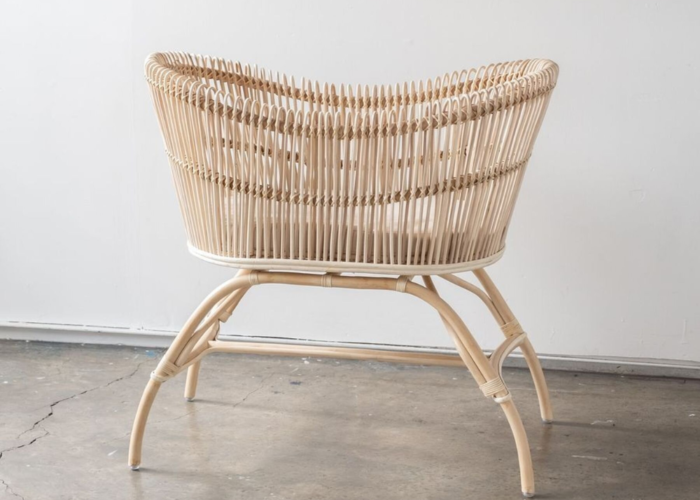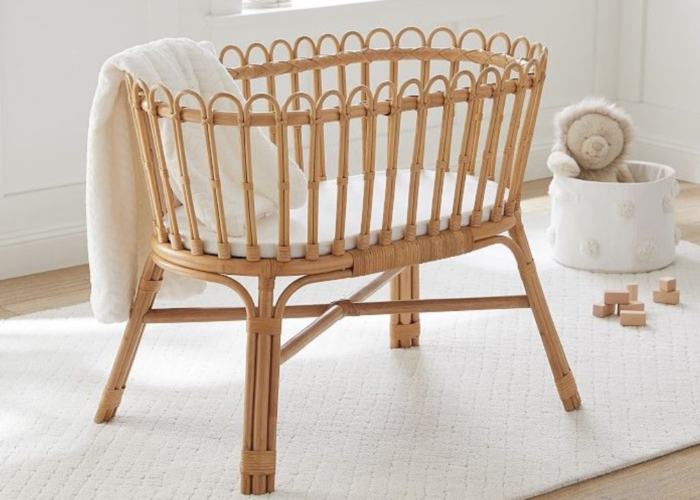If you’ve chosen a wicker bassinet as your baby’s first bed, you’ve opted for both style and tradition. However, as with any baby gear, regular cleaning is essential to maintain a healthy and safe space for your newborn. In this guide, we’ll walk you through the step-by-step process of how to clean a wicker bassinet, keeping it pristine and comfortable for your precious bundle of joy.
Contents
1. How to clean a wicker bassinet?
A wicker crib is a beautiful and airy choice for your baby. However, to keep it clean and safe, you should follow these steps:
Step1: Dust removal
Use a small handheld vacuum or a narrow attachment to remove dust from the surface of the crib. This will eliminate dirt, hair, and airborne particles.

Step 2: Preparing a cleaning solution
Mix a small amount of mild soap or detergent with warm water. If there are stains, mold or mildew, you can mix a solution of 1-part white vinegar and 3-part water.
You can add a bit of oxygenated water to the soapy solution for disinfection and brightening the wicker.
Step 3: Wiping the bassinet
Wipe the wicker bassinet with a micro fiber cloth dipped in a mild soapy water solution that has been wrung out. Gently scrub along the wicker strands, avoiding excessive wetness that could damage the wicker. Then, employ a small brush to clean the crevices and corners of the crib.
Step 4: Drying
Dry the crib with a dry cloth or let it air-dry in a well-ventilated area. Ensure the crib is completely dry before putting back the mattress and baby’s bedding.
Step 5: Regular checks
Periodically inspect the crib, paying special attention to joints and any broken or loose wicker strands. If you notice any issues, promptly repair or replace them to avoid potential hazards for your baby.
These steps will help maintain the cleanliness and safety of your wicker crib.
2. How to refinish a wicker bassinet?
A wicker crib can be refreshed by either repainting or using wicker care products. To repaint a wicker crib, you’ll need tools such as a brush, a cloth, paint, and a protective coating. Choose a type of paint suitable for the crib’s wicker material, such as oil-based paint for natural wicker and water-based paint for synthetic wicker. Also, choose a color that harmonizes with your baby’s nursery.
The steps to repaint a wicker crib bassinet are as follows:
- Clean the crib with a damp cloth to remove dust and stains. Place the crib on a large tarp to prevent staining the floor.
- Use a brush to evenly apply the paint to the wicker strands, being careful not to miss or spill too much paint. Allow the paint to dry completely following the manufacturer’s instructions, typically between 2 to 4 hours.
If necessary, you can apply an additional layer or two to enhance durability and coverage. After painting, you can apply a protective wicker coating to add shine and prevent moisture for the crib.
Allow the protective coating to dry completely before placing the mattress and bedding back into the crib. By following these steps, you have successfully refreshed a wicker crib for your beloved baby.

3. FAQs
3.1 Are wicker bassinets safe?
Wicker bassinets are a popular choice for many parents when selecting a crib for their baby. However, not all wicker bassinets are safe and meet current standards. To ensure the safety of your baby, pay attention to several factors after purchasing a wicker bassinet:
- Material: Choose a bassinet made of natural wicker, avoiding the use of chemicals such as paint, glue, or solvents to prevent skin irritation or allergies for the baby.
- Construction: Opt for a bassinet with a sturdy structure, without large gaps or sharp edges that could cause entrapment or injury to the baby. Additionally, check for any broken or protruding wicker strands to avoid potential hazards.
- Mattress: Select a mattress that fits the bassinet’s size appropriately, neither too thick nor too thin, to ensure the baby can lie comfortably and safely. The mattress should also be made of breathable materials to prevent overheating or moisture for the baby.
- Bassinet Placement: Place the bassinet in a cool, clean area, away from heat sources or electrical equipment. Also, avoid positioning the bassinet near windows, curtains, or high-hanging objects that could potentially fall and harm the baby.
By adhering to these principles, you can rest assured that a wicker bassinet is a safe and convenient choice for your baby. Nevertheless, it is essential to monitor and regularly inspect the bassinet to detect and address any issues that may arise promptly.
3.2 What kind of paint can you use on a baby crib?
When choosing paint for a baby crib, it’s crucial to prioritize safety. Opt for a non-toxic, baby-safe paint that is free from harmful chemicals. Look for water-based or milk-based paints, as they tend to have fewer volatile organic compounds (VOCs) and are generally considered safer for indoor use. Make sure the paint is labeled as “low-VOC” or “zero-VOC” to minimize the risk of exposing your baby to potentially harmful substances.
It’s advisable to choose paints specifically designed for children’s furniture or nursery items, as they undergo testing to meet safety standards. Always follow the manufacturer’s guidelines regarding application, drying times, and curing processes. Additionally, consider paints with a durable finish that is easy to clean and maintain, given the wear and tear baby furniture often experiences.
Remember to sand the crib’s surface lightly before painting to ensure better paint adherence. Allow the paint to cure thoroughly and off-gas in a well-ventilated area before placing bedding or allowing your baby to use the crib.
3.3 Do I need to seal the paint on a crib?
Yes, it is advisable to seal the paint on a crib for added durability and to create a protective barrier. Sealing the paint helps safeguard it from wear and tear, stains, and makes it easier to clean. Additionally, it can prevent the crib’s surface from being scratched or chipped, ensuring a longer lifespan for the painted finish.
When choosing a sealant for a crib, opt for a clear, non-toxic, and baby-safe sealant. Look for products labeled as child-friendly or designed for nursery furniture. Water-based polyurethane or polycrylic sealers are commonly recommended for sealing painted surfaces in baby nurseries. These sealants provide a clear protective layer without emitting strong fumes or harmful chemicals.
Ensure proper ventilation during the sealing process, and follow the manufacturer’s guidelines for application and drying times. Allow the sealant to cure thoroughly before placing bedding or allowing your baby to use the crib. This extra step can contribute to the overall safety and longevity of the painted crib.
4. Final thought
Regular maintenance will not only keep the wicker bassinet looking beautiful but also ensure a healthy and hygienic environment for your baby to thrive in. Remember, a well-maintained bassinet not only reflects your commitment to your baby’s well-being but also preserves the charm and longevity of this timeless piece of nursery furniture.
Here’s to many peaceful and restful nights for both you and your precious bundle of joy!
If you have any further questions, don’t hesitate to send thanhcongcraft an email us at [email protected] or message us at WhatsApp: +84967485411. Hope to serve you soon! Best regard!


